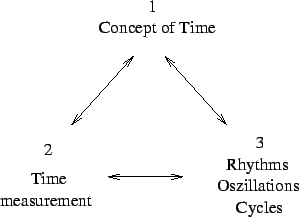
|
Like many fundamental concepts, time is difficult to define in words, but most of us refer to it and use it whenever we look at a clock. We measure time in seconds, minutes, hours, days, and years. The internationally agreed definition of the second is the time it takes for 9,192,631,770 cycles of a frequency that resonates with an atom of cesium.
What is 'time'? The first answer that often comes to mind is something similar to an immaterial linear continuum where only one point on that continuum called present exists. There are no start and end points similar to space. Being asked what time it is one gets answers like 12 hours and 23 minutes past midnight, a measurement technique which restarts counting every 24 hours. Starting from these three contrasting views of time I would like to shed a little light on several aspects of the perception of time.
Figure 2.3 illustrates these three fundamental aspects mentioned above. They are very much interrelated: (1) Time as a fundamental concept, its measurements (2) and the applications of oscillations or rhythms (3).
Time in the Hindu philosophy is perceived as a wheel instead of being conceived of as linear, and inherent in the concept of a spinning wheel is the notion of rhythm (London, 1997).
In the GIS literature time is often considered as a third (or fourth in 3D systems) dimension in addition to space. This resulted to the often used term of the space-time-cube. At first this looks very appealing, but it might be misleading. It mixes the continuous spatial aspect, where two or more spatial points can coexist, with the temporal aspect, where only one time-point can exist at a time. In addition there is only one direction possible on the time axis pointing from the 'past' to the 'future'. I would propose a new term called the space-time-elevator which symbolizes the two above-mentioned differences between space and time.
I will first go through various aspects of time measurement. Then the use of time in our language is discussed. In the last section about the conception of time I will provide an overview of the handling of time in computer science.